COPD: A Personal and Professional Nursing Perspective and Analysis
VerifiedAdded on 2022/09/25
|8
|1933
|19
Report
AI Summary
This report presents a nursing perspective on chronic obstructive pulmonary disease (COPD) through a blog format, detailing the experiences of an Aboriginal patient named Birrani Jiemba. The report explores the patient's diagnosis, admission to the hospital, cultural shock, and lifestyle reforms, highlighting the challenges of integrating traditional beliefs with Western medicine. Birrani's narrative emphasizes the impact of COPD on his life, including the need for lifestyle changes like quitting smoking and alcohol consumption. The report discusses the importance of cultural competence in nursing, the patient's perspective on healthcare, and the significance of lifestyle reforms in managing COPD. The author reflects on the patient's experiences, highlighting the barriers of equitable healthcare and the need for culturally sensitive nursing practices. Finally, the author outlines three specific nursing actions, including enrolling in cultural competence classes, creating awareness programs, and practicing empathy in patient care, to improve healthcare outcomes for Aboriginal patients and others with diverse cultural backgrounds. The report also emphasizes the importance of financial support for routine medical check-ups to reduce the burden of diseases among the Indigenous community. The report highlights the importance of empathy in nursing care and its role in facilitating quick healing and diagnosis.
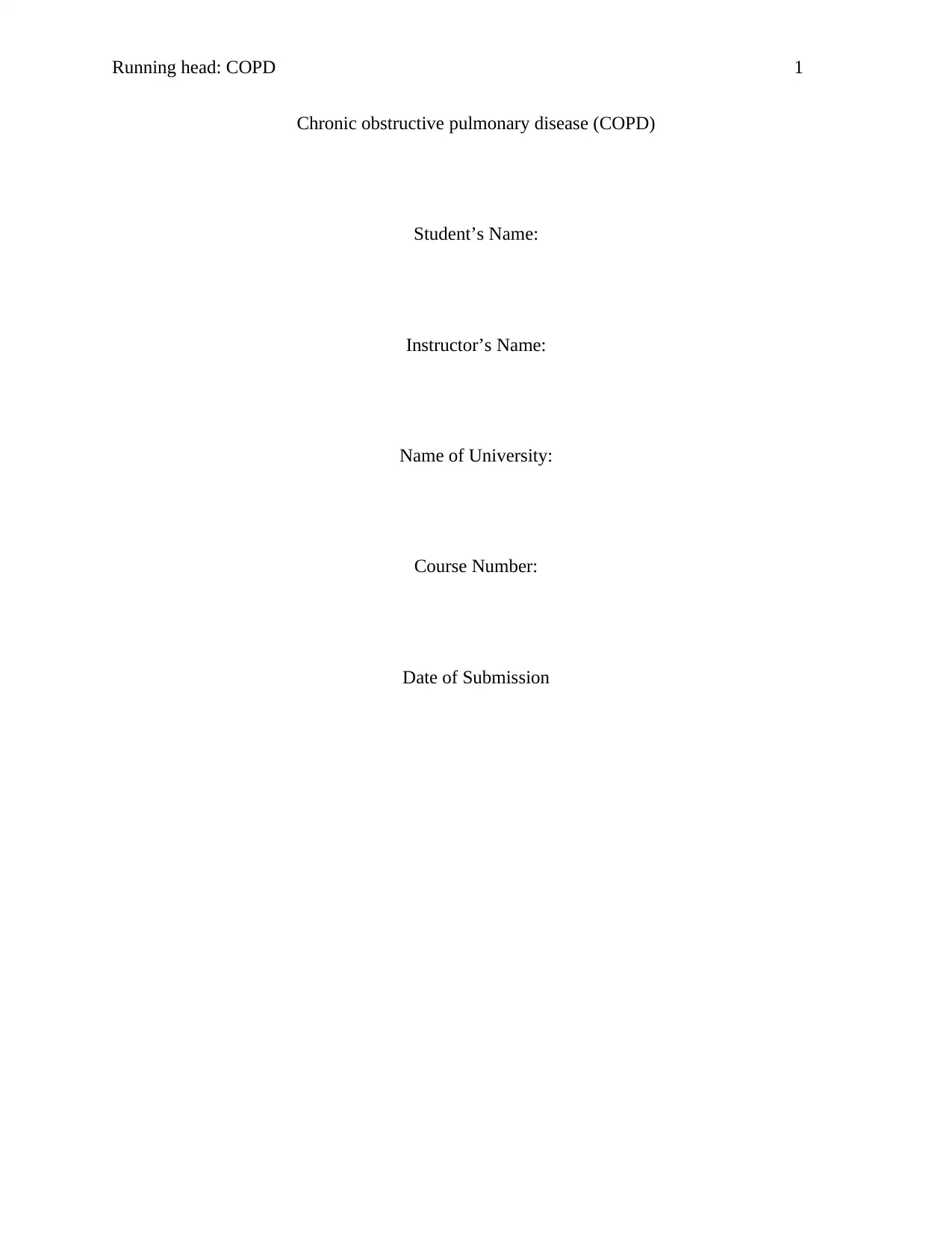
Running head: COPD 1
Chronic obstructive pulmonary disease (COPD)
Student’s Name:
Instructor’s Name:
Name of University:
Course Number:
Date of Submission
Chronic obstructive pulmonary disease (COPD)
Student’s Name:
Instructor’s Name:
Name of University:
Course Number:
Date of Submission
Paraphrase This Document
Need a fresh take? Get an instant paraphrase of this document with our AI Paraphraser
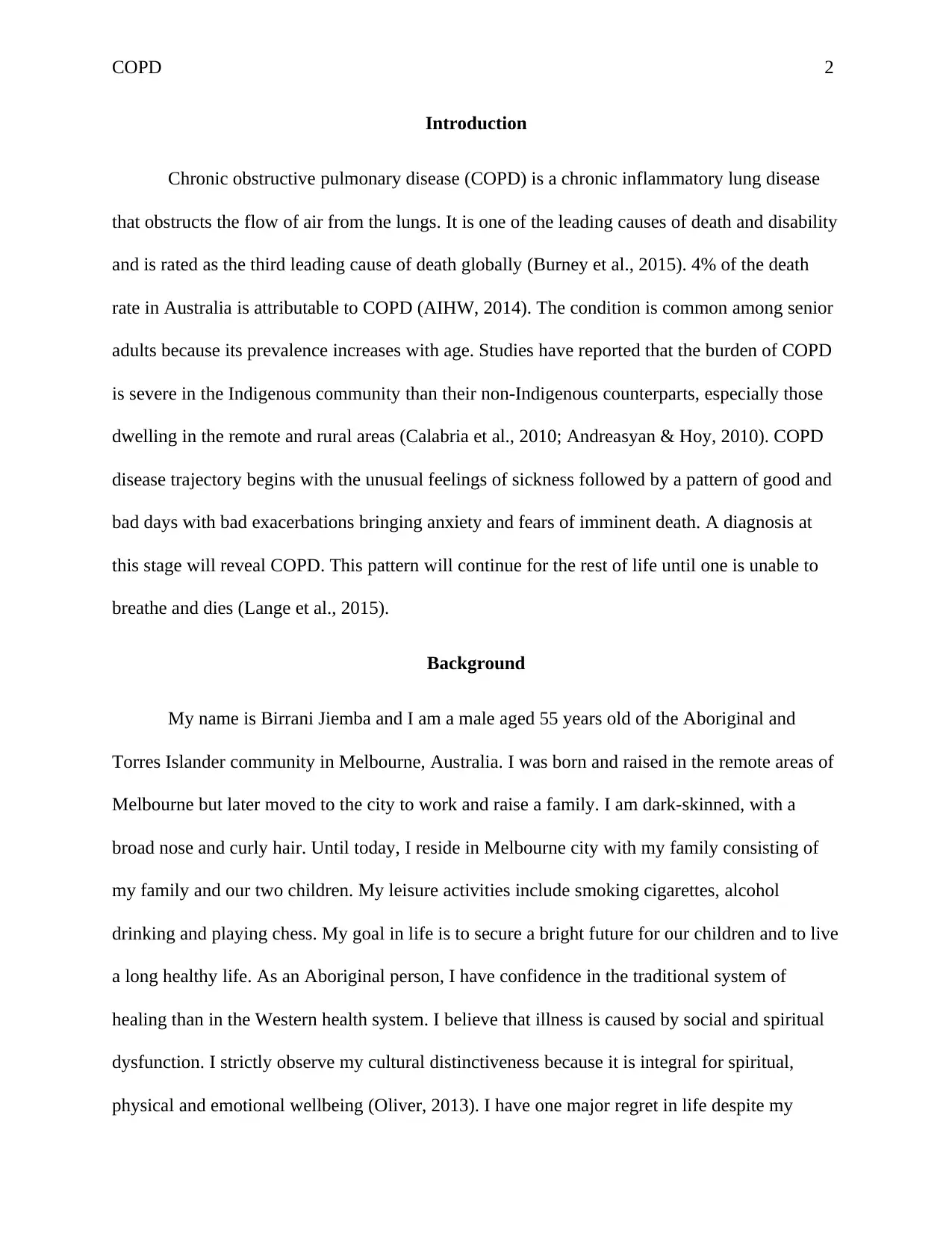
COPD 2
Introduction
Chronic obstructive pulmonary disease (COPD) is a chronic inflammatory lung disease
that obstructs the flow of air from the lungs. It is one of the leading causes of death and disability
and is rated as the third leading cause of death globally (Burney et al., 2015). 4% of the death
rate in Australia is attributable to COPD (AIHW, 2014). The condition is common among senior
adults because its prevalence increases with age. Studies have reported that the burden of COPD
is severe in the Indigenous community than their non-Indigenous counterparts, especially those
dwelling in the remote and rural areas (Calabria et al., 2010; Andreasyan & Hoy, 2010). COPD
disease trajectory begins with the unusual feelings of sickness followed by a pattern of good and
bad days with bad exacerbations bringing anxiety and fears of imminent death. A diagnosis at
this stage will reveal COPD. This pattern will continue for the rest of life until one is unable to
breathe and dies (Lange et al., 2015).
Background
My name is Birrani Jiemba and I am a male aged 55 years old of the Aboriginal and
Torres Islander community in Melbourne, Australia. I was born and raised in the remote areas of
Melbourne but later moved to the city to work and raise a family. I am dark-skinned, with a
broad nose and curly hair. Until today, I reside in Melbourne city with my family consisting of
my family and our two children. My leisure activities include smoking cigarettes, alcohol
drinking and playing chess. My goal in life is to secure a bright future for our children and to live
a long healthy life. As an Aboriginal person, I have confidence in the traditional system of
healing than in the Western health system. I believe that illness is caused by social and spiritual
dysfunction. I strictly observe my cultural distinctiveness because it is integral for spiritual,
physical and emotional wellbeing (Oliver, 2013). I have one major regret in life despite my
Introduction
Chronic obstructive pulmonary disease (COPD) is a chronic inflammatory lung disease
that obstructs the flow of air from the lungs. It is one of the leading causes of death and disability
and is rated as the third leading cause of death globally (Burney et al., 2015). 4% of the death
rate in Australia is attributable to COPD (AIHW, 2014). The condition is common among senior
adults because its prevalence increases with age. Studies have reported that the burden of COPD
is severe in the Indigenous community than their non-Indigenous counterparts, especially those
dwelling in the remote and rural areas (Calabria et al., 2010; Andreasyan & Hoy, 2010). COPD
disease trajectory begins with the unusual feelings of sickness followed by a pattern of good and
bad days with bad exacerbations bringing anxiety and fears of imminent death. A diagnosis at
this stage will reveal COPD. This pattern will continue for the rest of life until one is unable to
breathe and dies (Lange et al., 2015).
Background
My name is Birrani Jiemba and I am a male aged 55 years old of the Aboriginal and
Torres Islander community in Melbourne, Australia. I was born and raised in the remote areas of
Melbourne but later moved to the city to work and raise a family. I am dark-skinned, with a
broad nose and curly hair. Until today, I reside in Melbourne city with my family consisting of
my family and our two children. My leisure activities include smoking cigarettes, alcohol
drinking and playing chess. My goal in life is to secure a bright future for our children and to live
a long healthy life. As an Aboriginal person, I have confidence in the traditional system of
healing than in the Western health system. I believe that illness is caused by social and spiritual
dysfunction. I strictly observe my cultural distinctiveness because it is integral for spiritual,
physical and emotional wellbeing (Oliver, 2013). I have one major regret in life despite my
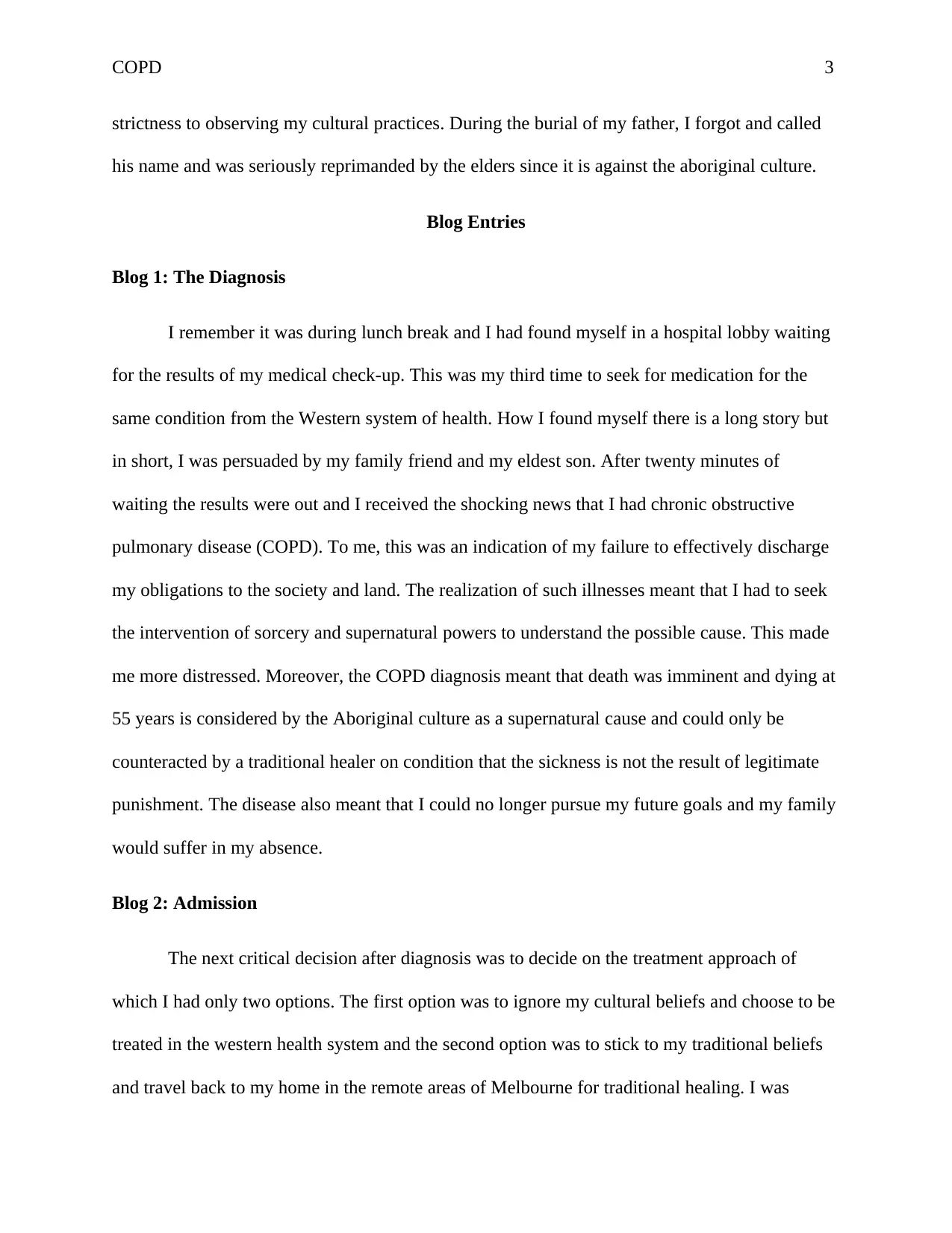
COPD 3
strictness to observing my cultural practices. During the burial of my father, I forgot and called
his name and was seriously reprimanded by the elders since it is against the aboriginal culture.
Blog Entries
Blog 1: The Diagnosis
I remember it was during lunch break and I had found myself in a hospital lobby waiting
for the results of my medical check-up. This was my third time to seek for medication for the
same condition from the Western system of health. How I found myself there is a long story but
in short, I was persuaded by my family friend and my eldest son. After twenty minutes of
waiting the results were out and I received the shocking news that I had chronic obstructive
pulmonary disease (COPD). To me, this was an indication of my failure to effectively discharge
my obligations to the society and land. The realization of such illnesses meant that I had to seek
the intervention of sorcery and supernatural powers to understand the possible cause. This made
me more distressed. Moreover, the COPD diagnosis meant that death was imminent and dying at
55 years is considered by the Aboriginal culture as a supernatural cause and could only be
counteracted by a traditional healer on condition that the sickness is not the result of legitimate
punishment. The disease also meant that I could no longer pursue my future goals and my family
would suffer in my absence.
Blog 2: Admission
The next critical decision after diagnosis was to decide on the treatment approach of
which I had only two options. The first option was to ignore my cultural beliefs and choose to be
treated in the western health system and the second option was to stick to my traditional beliefs
and travel back to my home in the remote areas of Melbourne for traditional healing. I was
strictness to observing my cultural practices. During the burial of my father, I forgot and called
his name and was seriously reprimanded by the elders since it is against the aboriginal culture.
Blog Entries
Blog 1: The Diagnosis
I remember it was during lunch break and I had found myself in a hospital lobby waiting
for the results of my medical check-up. This was my third time to seek for medication for the
same condition from the Western system of health. How I found myself there is a long story but
in short, I was persuaded by my family friend and my eldest son. After twenty minutes of
waiting the results were out and I received the shocking news that I had chronic obstructive
pulmonary disease (COPD). To me, this was an indication of my failure to effectively discharge
my obligations to the society and land. The realization of such illnesses meant that I had to seek
the intervention of sorcery and supernatural powers to understand the possible cause. This made
me more distressed. Moreover, the COPD diagnosis meant that death was imminent and dying at
55 years is considered by the Aboriginal culture as a supernatural cause and could only be
counteracted by a traditional healer on condition that the sickness is not the result of legitimate
punishment. The disease also meant that I could no longer pursue my future goals and my family
would suffer in my absence.
Blog 2: Admission
The next critical decision after diagnosis was to decide on the treatment approach of
which I had only two options. The first option was to ignore my cultural beliefs and choose to be
treated in the western health system and the second option was to stick to my traditional beliefs
and travel back to my home in the remote areas of Melbourne for traditional healing. I was
⊘ This is a preview!⊘
Do you want full access?
Subscribe today to unlock all pages.

Trusted by 1+ million students worldwide
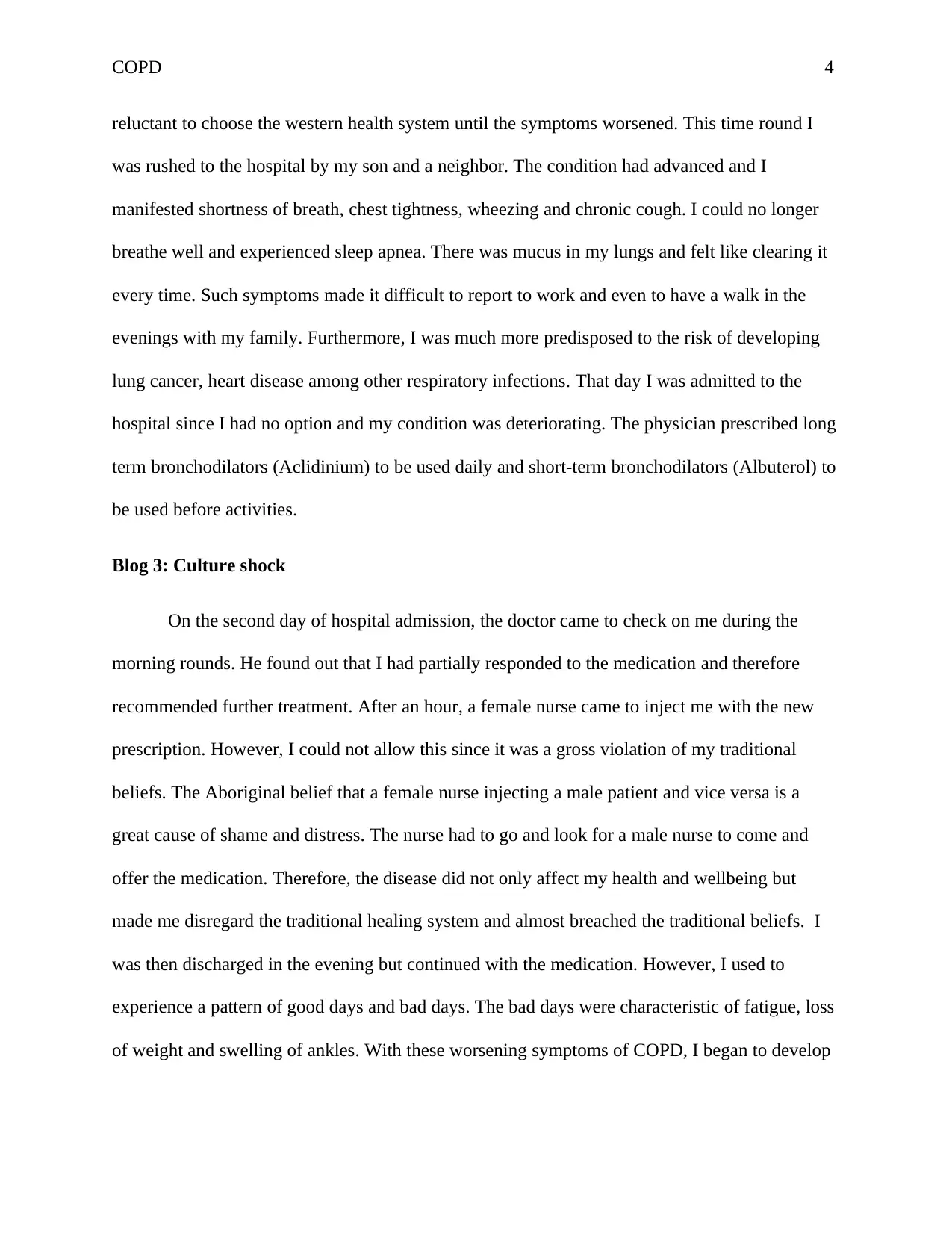
COPD 4
reluctant to choose the western health system until the symptoms worsened. This time round I
was rushed to the hospital by my son and a neighbor. The condition had advanced and I
manifested shortness of breath, chest tightness, wheezing and chronic cough. I could no longer
breathe well and experienced sleep apnea. There was mucus in my lungs and felt like clearing it
every time. Such symptoms made it difficult to report to work and even to have a walk in the
evenings with my family. Furthermore, I was much more predisposed to the risk of developing
lung cancer, heart disease among other respiratory infections. That day I was admitted to the
hospital since I had no option and my condition was deteriorating. The physician prescribed long
term bronchodilators (Aclidinium) to be used daily and short-term bronchodilators (Albuterol) to
be used before activities.
Blog 3: Culture shock
On the second day of hospital admission, the doctor came to check on me during the
morning rounds. He found out that I had partially responded to the medication and therefore
recommended further treatment. After an hour, a female nurse came to inject me with the new
prescription. However, I could not allow this since it was a gross violation of my traditional
beliefs. The Aboriginal belief that a female nurse injecting a male patient and vice versa is a
great cause of shame and distress. The nurse had to go and look for a male nurse to come and
offer the medication. Therefore, the disease did not only affect my health and wellbeing but
made me disregard the traditional healing system and almost breached the traditional beliefs. I
was then discharged in the evening but continued with the medication. However, I used to
experience a pattern of good days and bad days. The bad days were characteristic of fatigue, loss
of weight and swelling of ankles. With these worsening symptoms of COPD, I began to develop
reluctant to choose the western health system until the symptoms worsened. This time round I
was rushed to the hospital by my son and a neighbor. The condition had advanced and I
manifested shortness of breath, chest tightness, wheezing and chronic cough. I could no longer
breathe well and experienced sleep apnea. There was mucus in my lungs and felt like clearing it
every time. Such symptoms made it difficult to report to work and even to have a walk in the
evenings with my family. Furthermore, I was much more predisposed to the risk of developing
lung cancer, heart disease among other respiratory infections. That day I was admitted to the
hospital since I had no option and my condition was deteriorating. The physician prescribed long
term bronchodilators (Aclidinium) to be used daily and short-term bronchodilators (Albuterol) to
be used before activities.
Blog 3: Culture shock
On the second day of hospital admission, the doctor came to check on me during the
morning rounds. He found out that I had partially responded to the medication and therefore
recommended further treatment. After an hour, a female nurse came to inject me with the new
prescription. However, I could not allow this since it was a gross violation of my traditional
beliefs. The Aboriginal belief that a female nurse injecting a male patient and vice versa is a
great cause of shame and distress. The nurse had to go and look for a male nurse to come and
offer the medication. Therefore, the disease did not only affect my health and wellbeing but
made me disregard the traditional healing system and almost breached the traditional beliefs. I
was then discharged in the evening but continued with the medication. However, I used to
experience a pattern of good days and bad days. The bad days were characteristic of fatigue, loss
of weight and swelling of ankles. With these worsening symptoms of COPD, I began to develop
Paraphrase This Document
Need a fresh take? Get an instant paraphrase of this document with our AI Paraphraser
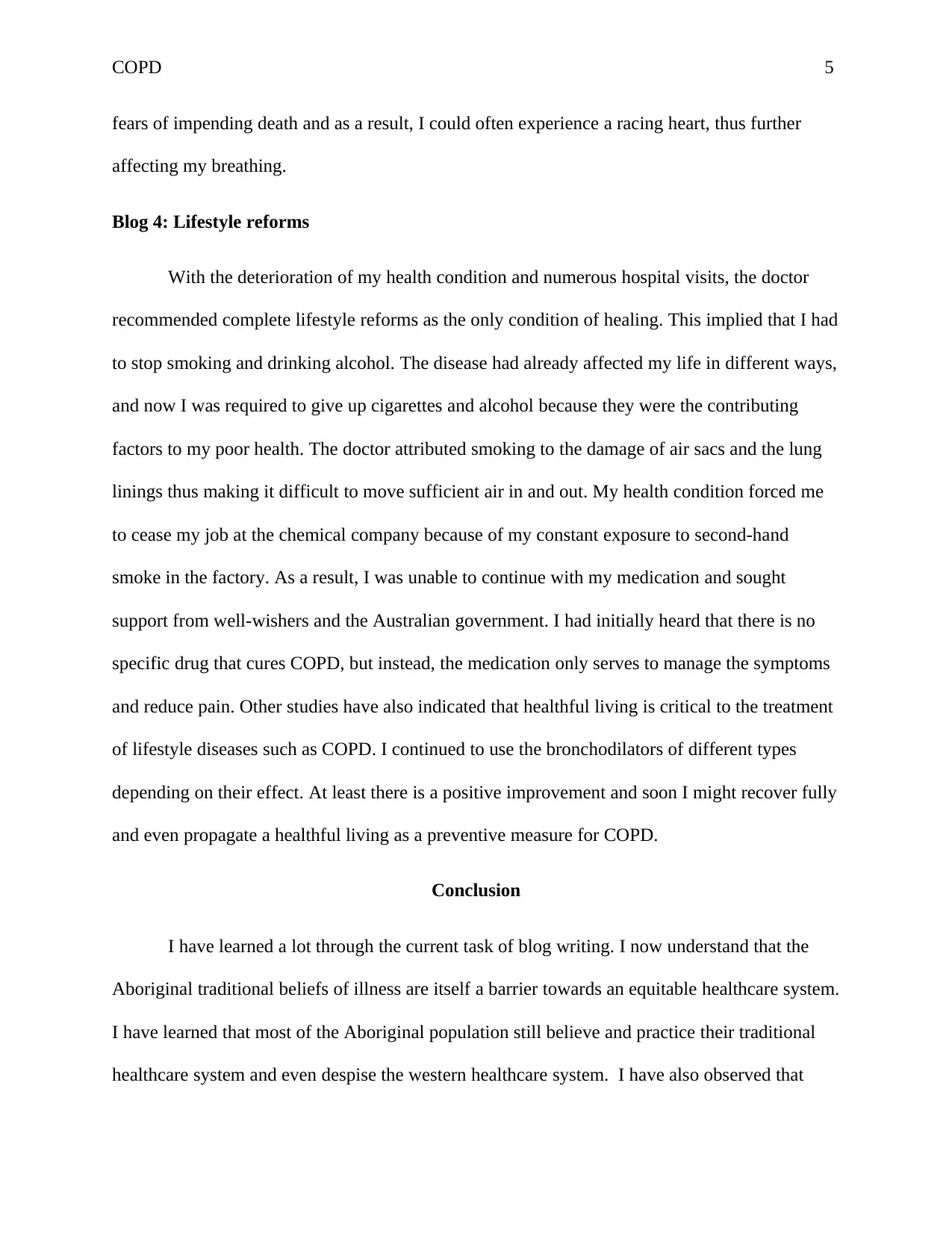
COPD 5
fears of impending death and as a result, I could often experience a racing heart, thus further
affecting my breathing.
Blog 4: Lifestyle reforms
With the deterioration of my health condition and numerous hospital visits, the doctor
recommended complete lifestyle reforms as the only condition of healing. This implied that I had
to stop smoking and drinking alcohol. The disease had already affected my life in different ways,
and now I was required to give up cigarettes and alcohol because they were the contributing
factors to my poor health. The doctor attributed smoking to the damage of air sacs and the lung
linings thus making it difficult to move sufficient air in and out. My health condition forced me
to cease my job at the chemical company because of my constant exposure to second-hand
smoke in the factory. As a result, I was unable to continue with my medication and sought
support from well-wishers and the Australian government. I had initially heard that there is no
specific drug that cures COPD, but instead, the medication only serves to manage the symptoms
and reduce pain. Other studies have also indicated that healthful living is critical to the treatment
of lifestyle diseases such as COPD. I continued to use the bronchodilators of different types
depending on their effect. At least there is a positive improvement and soon I might recover fully
and even propagate a healthful living as a preventive measure for COPD.
Conclusion
I have learned a lot through the current task of blog writing. I now understand that the
Aboriginal traditional beliefs of illness are itself a barrier towards an equitable healthcare system.
I have learned that most of the Aboriginal population still believe and practice their traditional
healthcare system and even despise the western healthcare system. I have also observed that
fears of impending death and as a result, I could often experience a racing heart, thus further
affecting my breathing.
Blog 4: Lifestyle reforms
With the deterioration of my health condition and numerous hospital visits, the doctor
recommended complete lifestyle reforms as the only condition of healing. This implied that I had
to stop smoking and drinking alcohol. The disease had already affected my life in different ways,
and now I was required to give up cigarettes and alcohol because they were the contributing
factors to my poor health. The doctor attributed smoking to the damage of air sacs and the lung
linings thus making it difficult to move sufficient air in and out. My health condition forced me
to cease my job at the chemical company because of my constant exposure to second-hand
smoke in the factory. As a result, I was unable to continue with my medication and sought
support from well-wishers and the Australian government. I had initially heard that there is no
specific drug that cures COPD, but instead, the medication only serves to manage the symptoms
and reduce pain. Other studies have also indicated that healthful living is critical to the treatment
of lifestyle diseases such as COPD. I continued to use the bronchodilators of different types
depending on their effect. At least there is a positive improvement and soon I might recover fully
and even propagate a healthful living as a preventive measure for COPD.
Conclusion
I have learned a lot through the current task of blog writing. I now understand that the
Aboriginal traditional beliefs of illness are itself a barrier towards an equitable healthcare system.
I have learned that most of the Aboriginal population still believe and practice their traditional
healthcare system and even despise the western healthcare system. I have also observed that
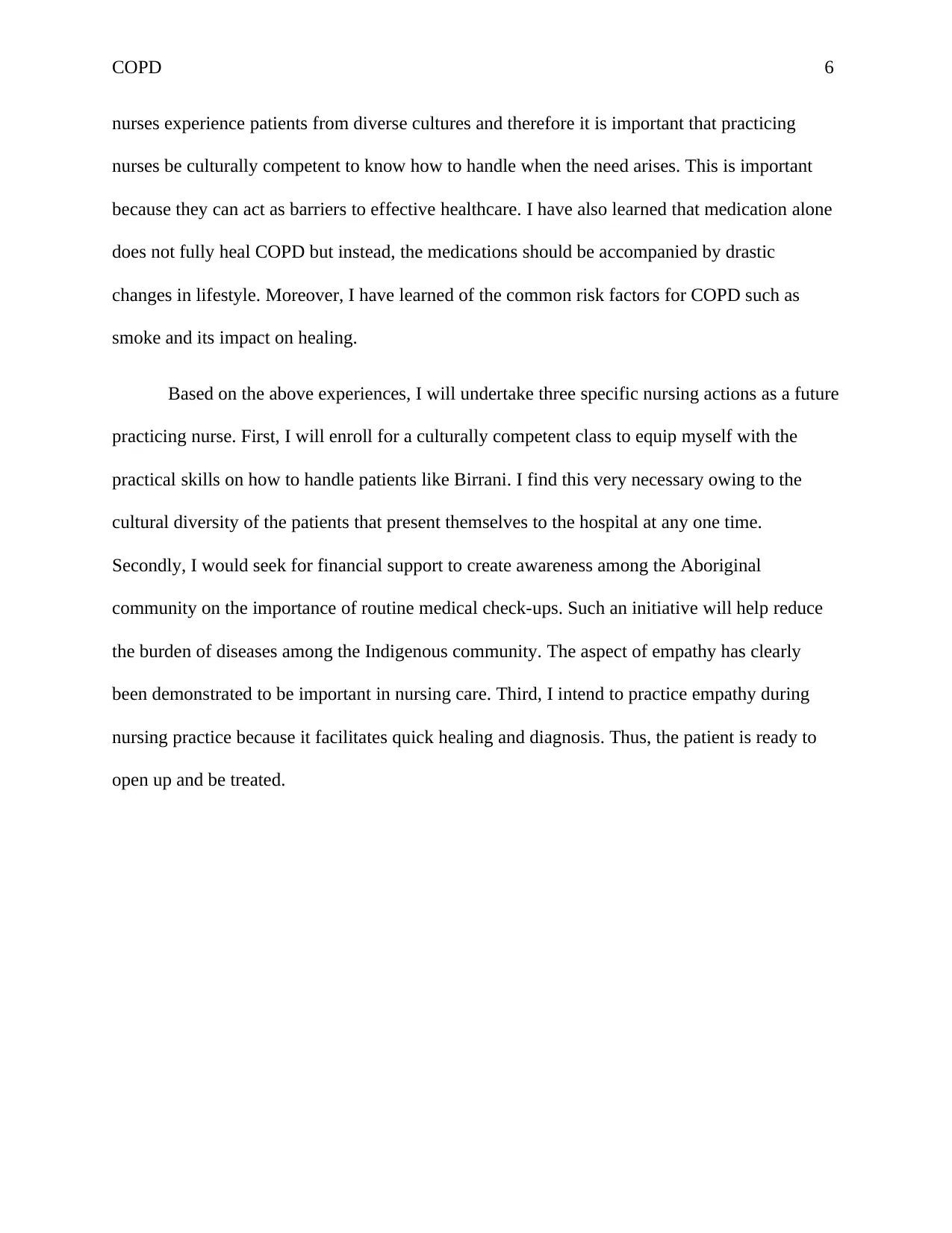
COPD 6
nurses experience patients from diverse cultures and therefore it is important that practicing
nurses be culturally competent to know how to handle when the need arises. This is important
because they can act as barriers to effective healthcare. I have also learned that medication alone
does not fully heal COPD but instead, the medications should be accompanied by drastic
changes in lifestyle. Moreover, I have learned of the common risk factors for COPD such as
smoke and its impact on healing.
Based on the above experiences, I will undertake three specific nursing actions as a future
practicing nurse. First, I will enroll for a culturally competent class to equip myself with the
practical skills on how to handle patients like Birrani. I find this very necessary owing to the
cultural diversity of the patients that present themselves to the hospital at any one time.
Secondly, I would seek for financial support to create awareness among the Aboriginal
community on the importance of routine medical check-ups. Such an initiative will help reduce
the burden of diseases among the Indigenous community. The aspect of empathy has clearly
been demonstrated to be important in nursing care. Third, I intend to practice empathy during
nursing practice because it facilitates quick healing and diagnosis. Thus, the patient is ready to
open up and be treated.
nurses experience patients from diverse cultures and therefore it is important that practicing
nurses be culturally competent to know how to handle when the need arises. This is important
because they can act as barriers to effective healthcare. I have also learned that medication alone
does not fully heal COPD but instead, the medications should be accompanied by drastic
changes in lifestyle. Moreover, I have learned of the common risk factors for COPD such as
smoke and its impact on healing.
Based on the above experiences, I will undertake three specific nursing actions as a future
practicing nurse. First, I will enroll for a culturally competent class to equip myself with the
practical skills on how to handle patients like Birrani. I find this very necessary owing to the
cultural diversity of the patients that present themselves to the hospital at any one time.
Secondly, I would seek for financial support to create awareness among the Aboriginal
community on the importance of routine medical check-ups. Such an initiative will help reduce
the burden of diseases among the Indigenous community. The aspect of empathy has clearly
been demonstrated to be important in nursing care. Third, I intend to practice empathy during
nursing practice because it facilitates quick healing and diagnosis. Thus, the patient is ready to
open up and be treated.
⊘ This is a preview!⊘
Do you want full access?
Subscribe today to unlock all pages.

Trusted by 1+ million students worldwide
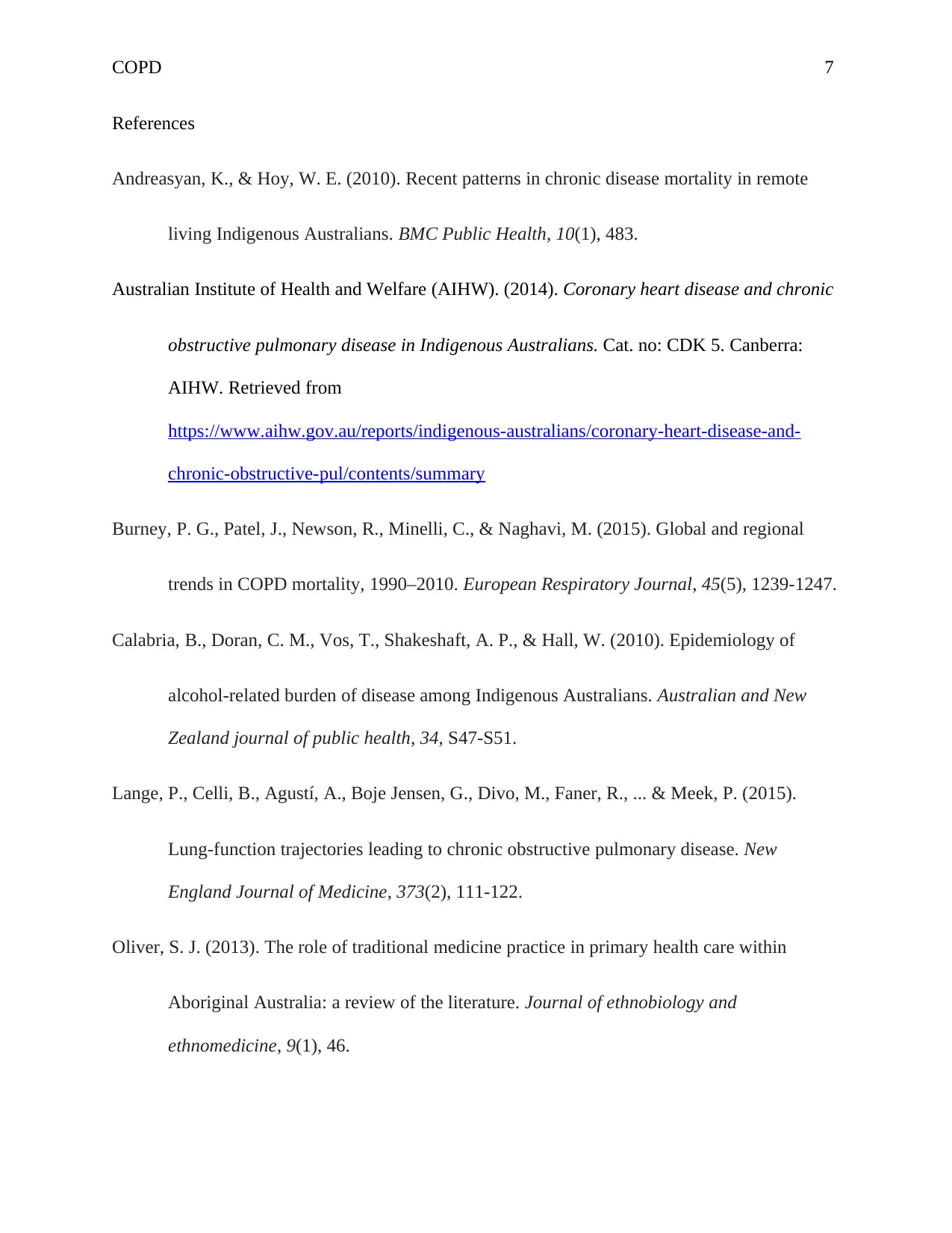
COPD 7
References
Andreasyan, K., & Hoy, W. E. (2010). Recent patterns in chronic disease mortality in remote
living Indigenous Australians. BMC Public Health, 10(1), 483.
Australian Institute of Health and Welfare (AIHW). (2014). Coronary heart disease and chronic
obstructive pulmonary disease in Indigenous Australians. Cat. no: CDK 5. Canberra:
AIHW. Retrieved from
https://www.aihw.gov.au/reports/indigenous-australians/coronary-heart-disease-and-
chronic-obstructive-pul/contents/summary
Burney, P. G., Patel, J., Newson, R., Minelli, C., & Naghavi, M. (2015). Global and regional
trends in COPD mortality, 1990–2010. European Respiratory Journal, 45(5), 1239-1247.
Calabria, B., Doran, C. M., Vos, T., Shakeshaft, A. P., & Hall, W. (2010). Epidemiology of
alcohol‐related burden of disease among Indigenous Australians. Australian and New
Zealand journal of public health, 34, S47-S51.
Lange, P., Celli, B., Agustí, A., Boje Jensen, G., Divo, M., Faner, R., ... & Meek, P. (2015).
Lung-function trajectories leading to chronic obstructive pulmonary disease. New
England Journal of Medicine, 373(2), 111-122.
Oliver, S. J. (2013). The role of traditional medicine practice in primary health care within
Aboriginal Australia: a review of the literature. Journal of ethnobiology and
ethnomedicine, 9(1), 46.
References
Andreasyan, K., & Hoy, W. E. (2010). Recent patterns in chronic disease mortality in remote
living Indigenous Australians. BMC Public Health, 10(1), 483.
Australian Institute of Health and Welfare (AIHW). (2014). Coronary heart disease and chronic
obstructive pulmonary disease in Indigenous Australians. Cat. no: CDK 5. Canberra:
AIHW. Retrieved from
https://www.aihw.gov.au/reports/indigenous-australians/coronary-heart-disease-and-
chronic-obstructive-pul/contents/summary
Burney, P. G., Patel, J., Newson, R., Minelli, C., & Naghavi, M. (2015). Global and regional
trends in COPD mortality, 1990–2010. European Respiratory Journal, 45(5), 1239-1247.
Calabria, B., Doran, C. M., Vos, T., Shakeshaft, A. P., & Hall, W. (2010). Epidemiology of
alcohol‐related burden of disease among Indigenous Australians. Australian and New
Zealand journal of public health, 34, S47-S51.
Lange, P., Celli, B., Agustí, A., Boje Jensen, G., Divo, M., Faner, R., ... & Meek, P. (2015).
Lung-function trajectories leading to chronic obstructive pulmonary disease. New
England Journal of Medicine, 373(2), 111-122.
Oliver, S. J. (2013). The role of traditional medicine practice in primary health care within
Aboriginal Australia: a review of the literature. Journal of ethnobiology and
ethnomedicine, 9(1), 46.
Paraphrase This Document
Need a fresh take? Get an instant paraphrase of this document with our AI Paraphraser
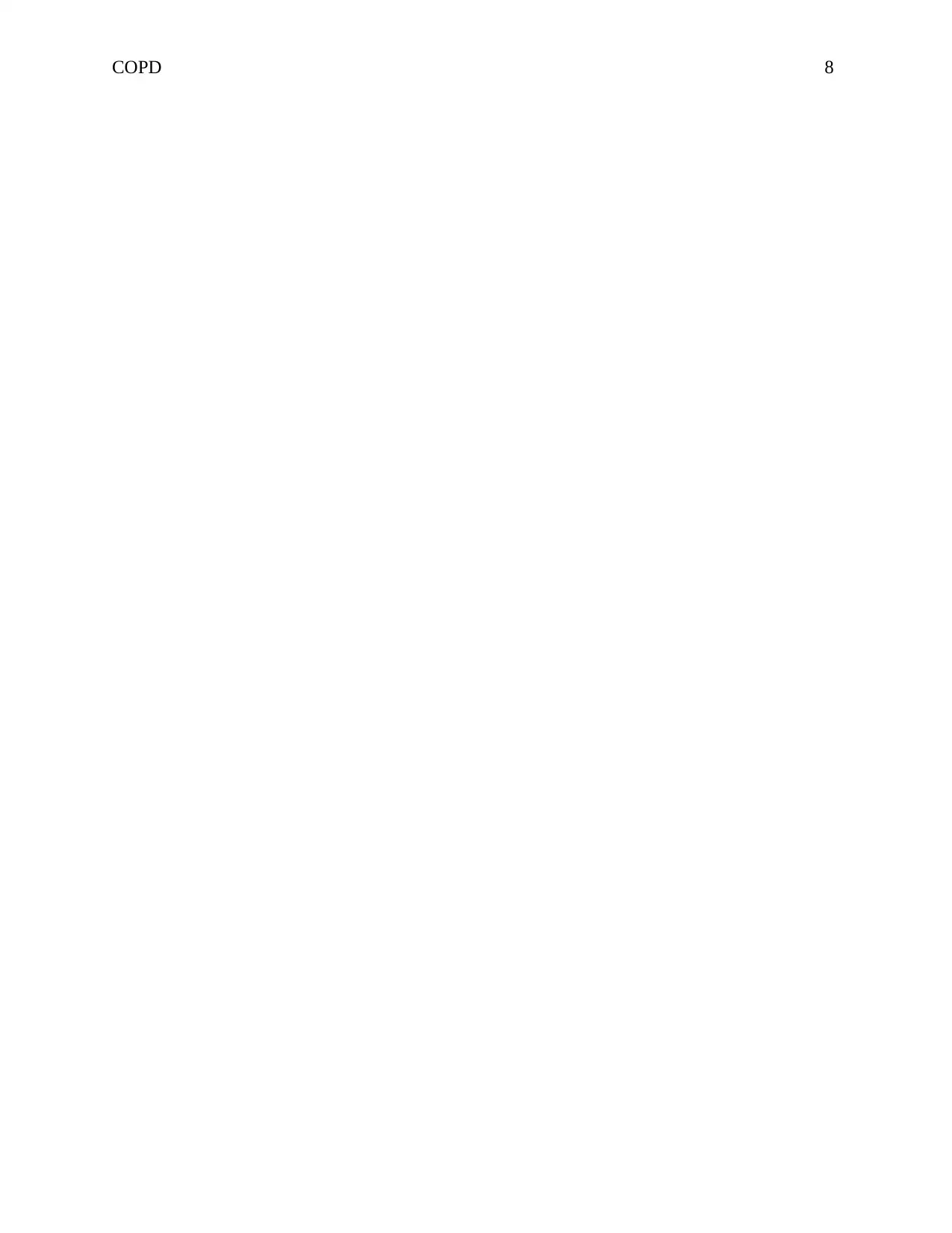
COPD 8
1 out of 8
Related Documents
Your All-in-One AI-Powered Toolkit for Academic Success.
+13062052269
info@desklib.com
Available 24*7 on WhatsApp / Email
![[object Object]](/_next/static/media/star-bottom.7253800d.svg)
Unlock your academic potential
Copyright © 2020–2025 A2Z Services. All Rights Reserved. Developed and managed by ZUCOL.





